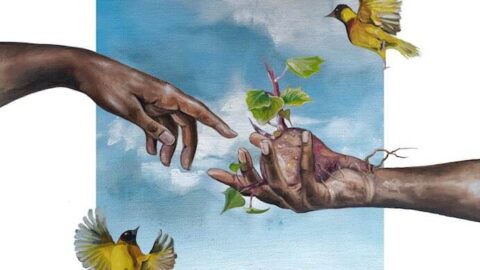Used to call, invoke, and speak to ancestral spirits, the instruments on Nyokabi Kariuki’s peace places: kenyan memories carry meaning and represent the act of passing knowledge down through generations. Out February 25, 2022, the SA Recordings EP features the mbira, the kalimba, and the gyil to encompass the memories of Kariuki’s lineage and the languages used to tell their stories. The mbira dates back more than 1,000 years, tracing to the Shona people of Zimbabwe. The kalimba is a smaller modern version of the mbira. And the gyil is a West African xylophone traced to Ghana.
Inspired by the artwork of a childhood friend, Naila – who painted the cover art and for whom the last track of the album is named (“Naila’s Peace Place”) – Kariuki’s sonic portraits describe physical locations rooted in peace: a state of mind as well as a state of being. Field recordings of background conversations and children playing envision a different kind of peace, contrary to the notion that being at (a place of) peace requires solitude or the act of isolating oneself. These communal stories, the ancestries Kariuki is a descendent of, are what her peaceful memories sound like.
Sitting at 0 degrees latitude, the equator runs through Kenya, and “Equator Song” opens the EP as the ground zero that Kariuki can physically walk on and spiritually launch from while mapping her genealogical memories. This track opens with a nine-beat pulse set by a layered, atonal voice counting numbers in Swahili, starting on eight (nane), down to one (moja), and back up to nine (tisa): nane, saba, sita, tano, nne, tatu, mbili, moja—then—moja, mbili, tatu, nne, tano, sita, saba, nane

Together, these counted numbers serve as the rhythmic foundation, establishing a peace chant while the sounds of chirping birds intermingle with sliding vocals that break apart the sound. Arpeggiations swell upward, evoking an image of maple syrup filling a mason jar too quickly and overflowing. Then the vocals slide down the sides, slowly, with the thickness of the piled intervals at its peak.
“A Walk Through Cucu’s Farm” is named for Kariuki’s grandmother, “cucu” being the word for “grandmother” in her ethnic group’s language, Kikuyu. The sound of crunching leaves serves as a walking bass line while an atmosphere of foggy air and thick wildlife builds on top. “Pole pole,” Swahili for “slowly slowly,” is repeated in the same way that “Hear! Hear!” is yelled during a speech. A humming voice is mimicked by various electronic sounds pulsing like blinking neon lights. This track has the most audible conversations on top of the music rather than beneath it, which is a most fitting tribute to her grandmother’s farm where her lineage manifested in the flesh.
“Galu” geographically places Kariuki’s peace on the eastern border with the Indian Ocean, opening with the sound of water disturbed by motion. After juxtaposing water with a ride cymbal for a full minute and thirty seconds, a repetition, in English slowly builds a staccato memory.
“I go down…
I go down at 6 am…
I go down at 6am to swim…
I go down at 6am to swim in the Indian Ocean.”
Like many of the tracks on this album, “Galu” uses an mbira and kalimba, handheld wooden box instruments that are plucked with the thumbs and index fingers and played inside a round gourd to project the sound. The metal keys, often spoon handles, combine with bottle caps or metal rings to produce a buzzing sound when played.
“Home piano” is a hanging suspension, like a perpetually unresolved chord progression that establishes the presence of a piano rather than the utility of it. This track uses rain, thunder, muffled speaking, kalimba, and marimba along with a myriad of other field recordings that hum, poke, sizzle, and chirp.
“Ngurumo, or Feeding Goats Mangoes” combines mbira, kalimba, and gyil. The vocals – distant, clustered intervals that move in and out of focus mixed with the bleating of goats – create exactly the sensation that these instruments represent: that of ancestral presence, like peace, felt yet unseen.

“Naila’s Peace Place” is in Lamu, a border island off the east coast of the Indian Ocean. It is said to be the oldest continually inhabited town in Kenya, and these long-spanning ancestral vibrations are captured by the vibraphone. On this track, the whistling of the wind grows stronger, dissipates, changes direction, and at times, stills. The added texture of the vibraphone’s sustain pedal gives the pitched wind, or breath, life — as if the dead provide a continuing sustenance of the land, the memories, and the peace rooted in and beneath them.
peace places: kenyan memories is a monumental collection of the sounds that define Kariuki’s memories in relationship to herself, her friends, her family, and her ancestral home. She pays homage to her land, her lineage, and her ancestral languages, but she also pays homage to peace through connection — and listeners of this album can very well discover their places of peace, too.
I CARE IF YOU LISTEN is an editorially-independent program of the American Composers Forum, funded with generous donor and institutional support. Opinions expressed are solely those of the author and may not represent the views of ICIYL or ACF.
A gift to ACF helps support the work of ICIYL. For more on ACF, visit the “At ACF” section or composersforum.org.
























